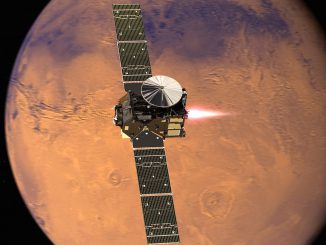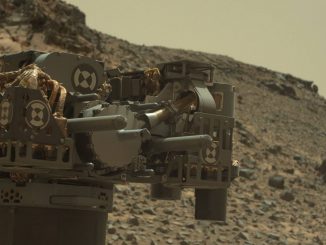
NASA’s Mars Curiosity rover has found fresh evidence for the past habitability of Mars and, in a striking observation, signs of repeating, seasonal variations in background levels of methane in the Martian atmosphere, a chemical that most commonly results from biological activity.
On Earth, at least.
Whether methane in the red planet’s thin atmosphere is a biomarker or the result of unrelated geochemical processes is not yet known. But the new findings strengthen the case for a habitable environment in the distant past and, possibly, the present.
“Today, we’re announcing the discovery of a repeatable, identifiable, seasonal pattern in the methane measurements,” Chris Webster, a senior research fellow at the Jet Propulsion Laboratory in Pasadena, California, said during a 7 June briefing.
“Not only have we got this wonderful repeatability, but the seasonal cycle changes by a factor of three. That’s a huge change, completely unexpected. And what it does, it gives us a key to unlocking the mysteries associated with Mars methane because now we have something to test our models and our understanding against.”
Observing seasonal changes in background methane levels is significant because 95 percent of the methane observed on Earth is the result of biology. But it only persists for a few centuries before it is broken down or escapes the atmosphere “so if we see methane in the Martian atmosphere, that means something is happening today,” Webster said, “it’s being released or it’s being created.”
He said the methane most likely originates below the surface of Mars and works its way up through fissures and cracks.
The gas has been detected before, but only in isolated plumes with no evidence for seasonal variations. Data from Curiosity is more nuanced, allowing researchers to detect those low-level variations. But the jury is still out on what is generating the gas.

“We don’t know if that methane is ancient, we don’t know if it’s modern,” Webster said. “It could be either. We also don’t know if that methane was created from rock chemistry or it was created by microbes.”
In a second report from Curiosity, researchers revealed detection of a wide variety of organic compounds, a requirement for life as it’s known on Earth, in three-billion-year-old rocks deposited on the floor of Gale Crater where Curiosity landed six years ago.
While organics were discovered earlier, the age and variety of the newly analysed samples strengthen the case for a habitable environment in the past.
“We found organic molecules in rocks from an ancient lakebed,” said Jen Eigenbrode, a research scientist and astrobiologist at NASA’s Goddard Space Flight Center in Greenbelt, Md. “Those organic molecules could have come from life.”
But she quickly added: “We don’t know that there was ever life on Mars, the organic molecules we found are not specific evidence of life because there are other sources of those molecules, including things that are non-biological in nature.”
But NASA managers say the new findings keep the door firmly open.
“With these new findings, Mars is telling us to stay the course and keep searching for evidence of life,” Thomas Zurbuchen, NASA science director at agency headquarters, said in a statement. “I’m confident that our ongoing and planned missions will unlock even more breathtaking discoveries.”



